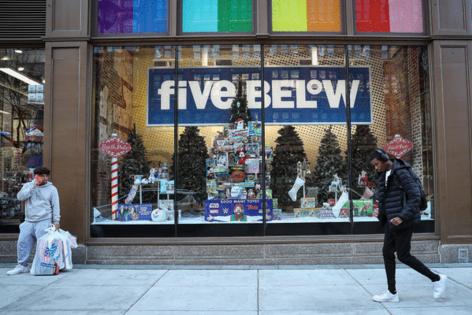How Five Below used AI to target tweens and cut costs
Published in Business News
Five Below, the Philadelphia-based chain with 1,800 stores that target middle schoolers and other young people, is in recovery, with sales growth and share price rebounding after a tough year.
Invent.ai, a 200-person Philadelphia software developer that uses artificial intelligence to automate product and inventory strategies, is taking some of the credit.
After coasting through COVID and the direct-sales boom that shrank and bankrupted many retailers, Five Below shares tumbled from $200 to as low as $65 last year after growth slowed and CEO Joel Anderson left. Anderson had championed larger stores and more expensive items. Cofounder Tom Vellios last year announced a return to Five Below’s low-priced roots, and the board hired former Forever 21 chief Winnie Park as chief executive.
The stock topped $120 after the company reported higher-than-expected first-quarter sales June 4, citing rising revenue from beauty products, loungewear, candy, and “collectibles” (such as Squishmallows plush toys).
Five Below is now “the cool store for kids, the yes store for parents,” Park told investors in a conference call that evening, adding the company plans to add a net 150 new stores this year. She credited better sales with improved, efficient inventory planning.
It’s been “a remarkable pivot,” Michael Lasser, an analyst for investment bank UBS, said during the call.
But Park warned of challenges ahead due to uncertainty over import costs. In early April, Five Below said it was stopping cargoes from China, which supplies more than half Five Below’s goods, in response to President Donald Trump’s tariff threats. Park said China shipments have since resumed but added that profit margins are weaker due to higher tariffs. The company is scouting new suppliers in India and elsewhere.
Invent.ai was founded in 2013 as Invent Analytics by Gurhan Kok, a Wharton-trained former Duke University analytics professor. With its use of AI software, which pulls information from images as well as familiar financial data, Invent.ai’s platform has been “a game-changer” for Five Below, the company’s chief strategy and analytics officer Graham Poliner said in a statement. He credited Invent.ai with helping “optimize inventory levels,” keeping stores from running out of popular items or getting stuck with unwanted extras, and projecting future demand for every product and store.
Since last year, Invent.ai staff have been working from Five Below’s Market Street headquarters in the former Lit Bros. building. The firm says it has developed detailed forecasts on how much kids want to buy, for each product at each store, and automatically determines the time and quality for new product orders.
Tav Tepfer, Invent.ai’s chief revenue officer, addressed key questions about the partnership. The interview has been edited for clarity and brevity.
Q: Your firm has added AI to its name, but what’s really new here?
A: The basis of big data and math optimization has been around for 50 years. We added Generative AI (which creates text and images) and Agentic AI (which makes decisions on its own) using structured and unstructured data.
Five Below is a great use case for AI. They had some legacy retail data systems, Blue Yonder, SAS Forecasting, which used rules-based, traditional approaches. When you deal with rules-based engines, you can’t just keep adding rules for those systems to apply. The data has to be all in the same formats before they can allocate or replenish inventory.
Five Below’s transactions have lower dollar amounts. When you try to take all the categories the company’s has — phone chargers, candy, home goods — it was a challenge to apply the same rules to each of those products and make sense of it all. A system that’s very rigid can’t handle that. It can start to break very quickly, like a bowl of spaghetti.
At first, Five Below started adding smart people to add more rules-based strategies behind the data. They hired data scientists. It meant lots of manual work for their planners, dumping things into spreadsheets, manipulating data into their format, dumping it back.
That takes time. But candy melts in a distribution center; you can’t let it sit forever.
Q: Five Below says your algorithms help plan inventory. How’s that work?
A: I call it hedge-fund math. It’s proprietary to us. We take their inventory and put it in a financial domain, so they can make trade-offs for carrying that inventory at that store, based on the probability that it’s going to sell [in a certain time period]. We get into AI decisioning, so their planners get the best decision for that piece of inventory without having to analyze and make human inputs, which are like guesses.
And we take all those nebulous rules, those averages on averages, and instead make AI decisions that are optimized to make the customer money, grow market share or revenue or margin, whatever their goal is.
Q: What’s a real-world example?
A: Candy. In Five Below stores located near a cinema, candy has a very different sell-through rate. And it gets stolen more often, so they’d be out of stock and not know it — they didn’t replenish it because sales records didn’t show what had happened. So then they could be losing significant sales.
Q: Where do you get that extra data?
A: We have an application called Phantom Inventory that understands when inventory should be there, but it’s not selling. We use product images. We can use weather data, social [media] data, event data. We use traffic data. We know the velocity of sales and when the drop-off rate doesn’t make sense of the inventory at hand. We know something went wrong.
Q: How did you get Five Below to buy your services?
A: Their CFO (Christy Chipman, who left the company earlier this month) found us. Their data scientists said it would cost millions and take years for them to build a system that did these things. Ours, they bought off the shelf.
Q: How much did you save Five Below?
A: They had 80% higher efficiency for their planners. You could say they got four days a week back for them because of all the manual work they didn’t have to do anymore. We did a statistically valid A/B test comparing orders with our system to business as usual. They saw a significant increase in revenue and margin. Inventory moved faster.
AI makes everybody more efficient. We like to say that we give company planners superpowers. Not just hind-sighting. We can do predictive analysis.
©2025 The Philadelphia Inquirer, LLC. Visit at inquirer.com. Distributed by Tribune Content Agency, LLC.












Comments